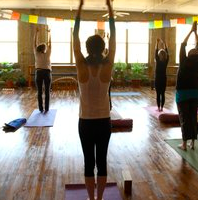“The asanas have no function of their own. It is only how they serve the practitioner.” –Gary Kraftsow, founder of the American Viniyoga Institute
Recently, my friend Maggie and I shared some thoughts about an online yoga class we’d both taken that was focused physically on…the butt. The vinyasa class was built around utkatasana (chair pose.) Maggie wrote to me, “Would you believe that I still hate utkatasana after all these years of yoga? It just does not jive for me. I actually can’t do it at all with my arms raised the way they are supposed to be.”
The “supposed to be” portion of her comment sent me into teacher mode, and as I teach to a general population at a Midwest small-town family facility and NOT Yoga Journal models, I thought to remind and encourage Maggie and others (and, um, myself) that variations of asana can be a good thing, and that “supposed to be” is often a negative stronghold.
I realize there are differing schools of thought regarding pose variation. I particularly appreciate the teachings of Sri. T. Krishnamacharya as outlined by his son T.K.V. Desikachar. In his book, The Heart of Yoga Developing a Personal Practice, Desikachar describes the functions of asana (pose) variations. “One reason we work with asana variations is to extend our physical capabilities,” he says. Since Patanjali describes asana as sthira and sukha, steady and comfortable, Desikachar contiunes, “Asana variations help us to achieve maximum gain with minimum effort by intelligently addressing our physical needs.” Varying asana to a person’s capabilities helps hold true the Sutra’s definition of asana as the Yoga practice develops. I find it important to remember that the Yoga Sutras don’t instruct us on asana form, so it is up to each person to learn and study how asana can serve their own Yoga path.
Colin Hall outlined this principle in his article on alignment, “Alignment is a tool that we use to produce particular results. However, the results are what we value, not the tool. Spending our time trying to “get it right” confuses the ends and means of yoga practice.”
Desikachar notes the importance of respecting the principles of the asanas when exploring variations, and encourages these questions, “What does this asana mean? What is its purpose? What does it demand of us? Only when we have come to understand the underlying principles can we do variations of an asana.” So in varying asana, there need to be first a knowledge of the pose and its objective as well as an awareness of one’s body and intent.
So starting with principle knowledge, (a good teacher can help!), what could mindful Maggie try in utkatasana? Traditionally, we may often see utkatasana like this:
- *Try the heels under the hips instead of “perfectly” pressing together. My massively muscled husband and I attended a yoga class once and as we moved into utkatasana, the instructor cued several times “heels and toes together,” directed at my guy. Due to his large muscles and DVT damaged thigh, he cannot, without pain, bring his feet together in chair pose. For the pose to work in his body, his heels stay grounded under his hip bones.
- *Shoulder tension or restriction? Try creating space by dropping the arms. Take the hands to Anjali Mudra (heart, prayer). Focusing on lifting the heart into the thumbs can help encourage lifting of the heart and lengthening of the spine instead of rounding forward.
- *Want to cultivate openness through the front body but still feel some tension in the shoulders? Try bending the elbows open and out to 90 degrees and feel the upper back pull gently to open the heart. I’ve heard this called cactus arms, although I prefer the football reference…
- *Open the upper back with Garuda Hastasana (eagle pose arms). Be mindful to maintain the action of the shoulders pulling back and lifting the heart as the elbows move away from the face.
- *Reach out! I find reaching the arms straight out from the shoulders helps to counter balance as one practices dropping the hips back. With awareness, this variation can also open inhibited areas in the shoulders and neck.
- *Add a different intensity…with the feet under the hipbones, lift the heels. Yowch!
- *How about chair pose in a chair?
Utkatasana in a chair. Credit: Fishman, LM and Saltonstall, E. Yoga for Osteoporosis. W.W. Norton, New York, sciatica.org
Can you think of any more?








Read 5 comments and reply